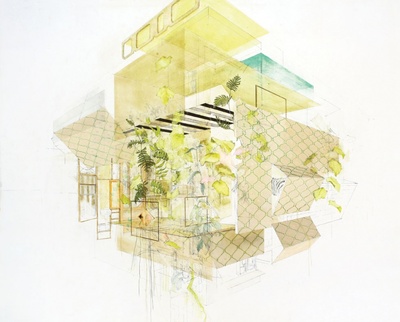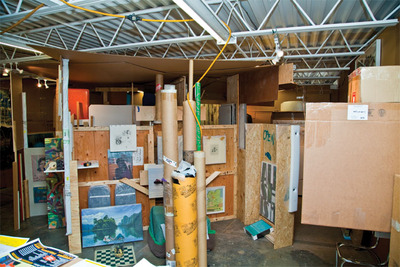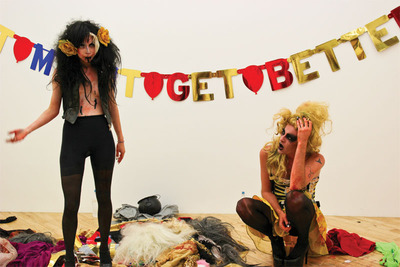A New Regionalism?
Art can be made anywhere an artist can survive, yet the contemporary art market remains provincial. This situation is almost like that of wine, but art has fewer areas of provenance taken seriously on the global marketplace. For their trophies, art connoisseurs in the United States rarely look beyond the shores of Manhattan, and over the last century or so, global galleries, auction houses, and even artists have directed the contemporary art market into increasingly specific channels of commerce.

Alyssa Dennis, Farm Camp, 2012
“In the twentieth century…new international or para-national formations occur, and they have tended to be avant-garde in the metropolitan centre,” Edward Said wrote in Culture and Imperialism. “To some extent these para-formations—Paris 1890–1930, New York 1940–1970—are the result of newly effective market forces that internationalize culture.”
Like an empire, the New York-concentrated art market absorbs resources from everywhere, but it may be the cities closest in that feel its concentric pull the most. New York’s proximity is “the biggest hindrance to Boston having a truly robust and meaningful gallery scene,” South End gallerist Steven Zevitas says. “There’s a solid group of Boston collectors, but their number is finite.” For people involved in the social aspects of collecting, it’s easy to skip down to New York to buy art. “If Boston was another 300 miles from New York, would that be different? Sure, maybe, but it’s difficult to answer.”
If we look at the number of commercial galleries in cities, taking into account their populations, there are signs of a regional sphere of influence surrounding New York. For a benchmark comparison of Boston to New York, consider the number of commercial gallery members in either the Art Dealers Association of America (ADAA) or New Art Dealers Alliance (NADA). Boston has two ADAA and three NADA members, whereas Manhattan alone can boast about 140 in the ADAA and forty-five gallery members in NADA plus individual dealers. Philadelphia, less than a two-hour drive from the Big Apple, has just two in the ADAA despite its population of 4 million people, about half that of New York’s.
The San Francisco metropolitan area, similar in culture and scale to Boston, has nine ADAA members and four NADA gallery members. Given the numbers, the farther a city is from New York, it seems, the healthier its art ecosystem. There are many galleries in Boston and elsewhere that aren’t members of ADAA or NADA, but according to NADA member Zevitas, who shows a few Bay Area artists, there are still “at least three times as many solid contemporary galleries there as in Boston.”
Southie gallerist Russell LaMontagne estimates that the city could actually support twenty contemporary galleries, fifteen more than the five that he and Zevitas consider to be colleagues. LaMontagne, who co-founded LFL Gallery in New York’s Chelsea neighborhood over a decade ago, admits that “showing Boston artists is really, really hard. It’s safer to buy a minor piece or a print by an established artist than a piece by an emerging artist in the same price range,” he says.
A Boston native himself, LaMontagne sees local artists as a vital part of the city’s art ecosystem. This past spring, he featured Malden-based Douglas Weathersby (aka Environmental Services) in a show dubbed Spring Clean!. The artist created a performative installation by curating an exhibition almost entirely from the gallery’s storage closet, a prospect many commercial gallerists would find daunting. “I don’t think we want to have a city where [local] artists don’t exhibit their work,” LaMontagne remarks. “Do we want to have a place that doesn’t produce primary art? That’s what we’ll get if we don’t have a vibrant commercial market here. We won’t produce primary art, and there won’t be such things as primary artists.”

Douglas Weathersby, installation view of Spring Clean!, 2012
Emerging artists struggle to be taken seriously on the national stage, but consider Canada, a country whose stereotypes rarely pay tribute to its culture or modernity. MASS MoCA curator Denise Markonish set out to provoke the art world into confronting its myopic view of where art is made with the long-term Oh, Canada exhibition. She writes in her catalogue essay that she thought “it would be funny” to produce such a show, but told ARTINFO Canada journalist Sky Goodden in a June interview that she intended it as a “dig at the art world.” Canadian artists suffer the regionalism issue, too, according to Markonish. “I heard that you have to leave [the country] in order to be recognized,” she told Goodden.

Douglas Weathersby, installation view of Spring Clean!, 2012
Indeed, “contributors to avant-garde movements,” Raymond Williams wrote in The Society of Culture, were immigrants to the metropolitan centre that Edward Said describes in Culture and Imperialism. They arrive “not only from outlying national regions but from other and smaller cultures, now seen as culturally provincial in relation to the metropolis.”
“I think a lot of artists who are trained in Boston, if they are going to have careers in contemporary art, will find themselves in New York either by moving themselves there or [by] finding ways to get their work shown there,” claims Cape Cod collector Alan Dinsfriend. He’s been buying art since the late 1970s and, in addition to New England artists Gerry Bergstein, Michael Beatty, and Isabel Riley, has amassed a broad collection that Zevitas calls “extraordinary” and “deep.” “If one is a serious collector of contemporary art, as a collector, you have to move on just as the artist has to move on,” he says. For New York, “the gravitation pull is almost irresistible.”
Boston’s most abundant and economically fecund resource is students, but their careers often take them elsewhere. Camilo Alvarez of Samsøn Projects in the South End, who with Zevitas and LaMontagne were the only Boston galleries to participate in the 2012 Volta Art Fair during New York’s Armory week, pondered Boston’s precious resource. “Students offer us a ground-level access that I’m not even sure contemporary art galleries or galleries in general fully take advantage of,” he says. Their presence provides jobs for thousands within the relatively limited bounds of Boston proper, but their energy, creativity, and entrepreneurial spirit are the means through which alternative spaces and artist-run galleries come together and replicate.
“In a thriving system, the schools feed the alternative spaces, which feed the commercial galleries, on up to the museums,” Boston Globe art critic Cate McQuaid wrote in January, exploring what her colleague Sebastian Smee referred to as Boston’s “anemic commercial gallery scene.” Boston’s crop of alternative spaces is arguably even wanner. Alvarez recently launched sübsamsøn, an artist-in-residence program, under his gallery. His neighbor Anthony Greaney, another commercial gallerist, has regularly held screenings and hosted performances of locally made student work, but these efforts only nourish the arts community so much. “You know what would be amazing?” Alvarez asks. “If all those Museum School and MassArt grad students stayed in Boston.”

Hayley Morgenstern and Creighton Baxter, It Might Get Better, 2012
“It can be discouraging to artists and gallerists in Boston to see what’s happening in New York and see how it’s impacting or pressuring them, and at the same time I want to reinforce for them, as well, the value of what we have here,” comments Jen Mergel, a Beantown native and senior curator of contemporary art, MFA, Boston. The proportion of institutions to commercial galleries in Boston is far different than in New York, “so the discourse and conversation are much different. There is a lot of great conversation around art, which I think is very healthy.”
It is healthy and keeps the heart of Boston’s arts community pumping, but Alvarez’s musing on students is a succinct diagnosis for the Hub’s art ecology. Students are emerging artists, but if there’s not an art community in which to emerge, they join the emigration. How to get more to remain? Fingers point blame at government, real estate, “anemic” arts coverage, and institutions, but let’s point a collective digit at our students.
Bushwickdaily.com recently counted forty-one galleries in the warehouse-abundant Brooklyn, New York neighborhood from which the publication takes its name. Many of those, such as Norte Mar and Valentine, noted by Holland Cotter in the New York Times, are in living rooms. Many more are run by recent graduates. Their spaces will live and die just as quickly as deceased Boston alternative spaces such as Oni Gallery, Ark, Yes.Oui.Si., Space Other, Art Interactive, 55 Gallery, Meme, 57 Delle, Nom D’artiste, and most recently, Axiom, but despite New York’s cost of living, they keep making it happen. If emerging and student artists wanted this in Boston, they could make it happen here, too.
I lived in Boston for fourteen years, but spent most of the last year in New York. When Bostonians learn of my relocation, they want to know how New York is treating me, but I want plainly to tell them what I’ve learned in the last twelve months: Boston wants you more.
_________________________________________________________________________________________________________
Christian Holland is a Boston- and Brooklyn-based writer, journalist, and essayist. He was executive editor and founding contributor of Big RED & Shiny, a Boston-based, nonprofit arts journal, and now contributes to numerous arts publications. Follow him on Twitter at www.twitter.com/CRHolland.
